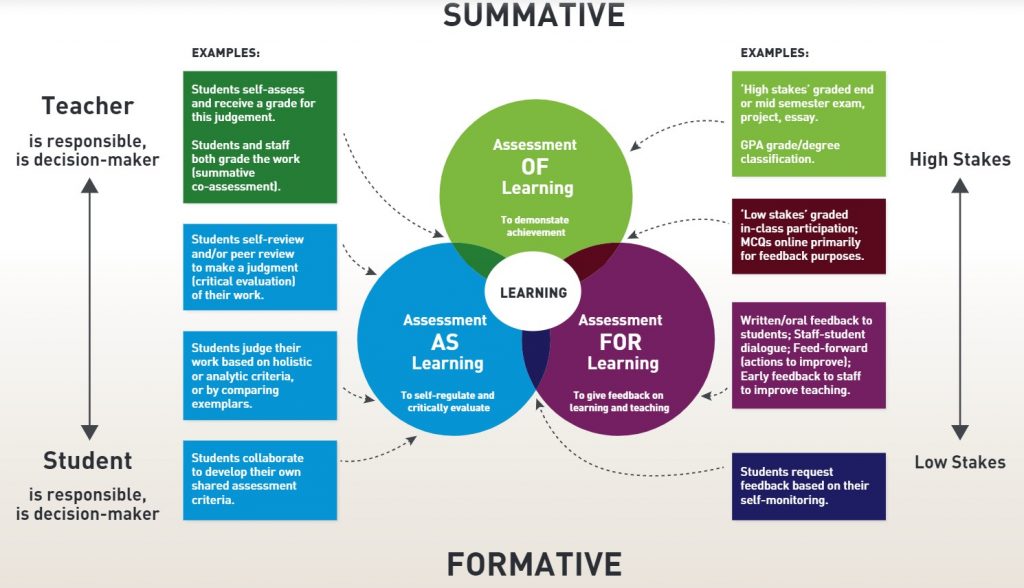Assessment Technology & Practices
(Week 3: Post 2)
In this week’s second presentation, we learned more about assessment technologies and practices and were reminded of assessment for, as and of learning and how that may look. They also discussed formative and summative assessments and walked us through a few different assessment technologies and discussed advantages, disadvantages, and some issues or problems that could arise with each one. One of the readings they included, was: 7 Smart, Fast Ways to do Formative Assessment, where the article discussed some ways to include fast formative assessments such as entry and exit-slips, interviews, self-assessments, etc. If you are looking for a good read on using assessment technologies on learning, the presentation group also provided a great resource that was easy to read and understand. You can find this article here.

Incorporation of Assessment Technologies in My Practice
In the past, I was pushed in the behaviorist learning theory direction, and assessments reflected this approach. Spelling tests, multiple choice quizzes, tests, right and wrong answers, etc. It was regurgitation at its finest let me tell you. But that was something that was valued under my administration and the school I was at. Being a new teacher, I felt obligated to follow the dominant assessment practices, and felt very much on the outside when trying new things or swaying from what most people were doing.

Although there are many cringe-worthy assessment practices in my past, I’d like to think that I am doing a better job now utilizing more constructivist, social constructivist, and connectivist pedagogies. From utilizing rubrics, 4-level scales, exemplars, whole-group built exemplars, self-reflection, peer reviews, conferences, etc. I am constantly trying to adopt new assessment practices and refine my own all of the time. I do like to use a plethora of different tools from Kahoot, Jamboard, Padlet, FlipGrid, etc. to Microsoft Word, PowerPoint, Google Docs, Slides, Forms, etc. I am trying things all of the time. I do know that a lot of my kiddos this year preferred to work on paper than technology, and many said that they didn’t use a ton of technology through their schooling and found that they needed a lot of support and guidance for the first half of the year to use their technology properly. While researching more about assessment, I found an interesting quick read called 10 Points to Consider in Choosing Alternative Assessment Methods for the Online Environment, from the National Forum for the Enhancement of Teaching and Learning in Higher Education.
When considering its implementation, first and foremost, edtech should be simple and reliable – otherwise you run the risk of adding to the burden already placed on teachers and hindering the learning process. History tells us that technology which doesn’t have these two essential ingredients often ends up like gym membership – paid for but hardly used.
Adbul Chohan
So, what does that mean for the future? Well, I hope to change things up even more and include some of the tools that my peers in EC&I833 have introduced or reminded me of. One of the assessment technologies that Laurie, Christina, Janelle, and Ramona introduced the class to and did a really good job of explaining was Plickers. I think Plickers would be a good mix of using technology and paper, and it was a tool that I had used way back when but hadn’t since (and boy does it look quite a lot different). I also really like how the presenters included relevant research to back up Plickers, in the article they included called: Using Technology for Formative Assessment to Improve Student’s Learning.
I also am really intrigued to learn more about Daniel’s math set-up that he discussed in his last blog post (you should really check it out—lots of opportunities for inquiry, group work, collaboration, conferencing, feedback, etc.). So I would like to incorporate more opportunities for authentic teamwork, discussions, and conferencing. I would also really like to include more opportunities to empower students to own their assessment practices as John Spencer suggests in the following video. If you really enjoyed watching this video, check out his playlist about crafting student-centered assessments.
The Learning Continues—Making Changes
Although there are many assessment tools that I have tried out, adopted, tossed, adapted, changed, etc. the learning process in terms of assessments tools is always evolving. Looking back on some of the assessment practices I utilized in my first few years of teaching has me cringing. Was some of it mandated by the school I was at and the division? Of course, but some of it on my part was just bad practice even if it was popular at the time. Education can be such a pendulum, at times it swings the total opposite way, sometimes it comes back to the middle, but most of the time it seems to swing wildly from one side to the other. Even though I would like to think that I have a lot of say in the assessment tools I use, I know that most of them are recommended, or strongly encouraged that we follow. It could be for consistency, financial, or other reasons, but there seems to be a strong push from higher up.

However, I guess the biggest change in my assessment practice is just not assessing absolutely everything that the students do. In math, I have two days in a row where the kiddos learn the same thing. The first day is a practice day, where they can try out a new skill being learned, time to ask questions, answer keys are given, etc., and students are not assessed on their work during practice time. The next day, I then give them a series of questions where they can show their learning. They can still ask questions and get feedback, and we still complete a few of the questions together, although this one I use for assessment purposes. I also don’t focus a ton on memorization anymore. I think there are certain things that we still work on memorizing (like our multiplication facts), however, these things are not assessed for grades.
Over time, I have also learned that the 4-level scale is great, and rubrics are my go-to for everything. As a learner, I like to know exactly what is being asked of me. I also like to include exemplars, as well as create an example together as a whole group. Over the years, some people haven’t liked this assessment practice of mine, saying that I am spoon-feeding the children, however, I believe that it is important to model what we are asking students to do. Is my assessment practice the golden boot? No. But it’s legit and it seems to be working for me as a teacher and for my kiddos. Could I do better at it? For sure. I am always open to learning and trying out new things. I do think though that we need proper professional development when trying out new assessment tools as well as examples of how other teachers have used them, etc.
Aligning School Division & Personal Assessment Practices
To be 1000% honest, this can be really difficult at times. Over my 11+ years of teaching, I have seen a lot come and go, and each year seems to be very different in terms of assessment practices than the last. Some years we were required to do standardized tests like the RAD, Vernon, DNA, etc. Although it wasn’t used as a mark, and only for school division data, I didn’t feel like they were great uses of our time, it made students anxious and the data didn’t really guide my practice in any way.

In prior years, we were asked to do the F&P (Fountas and Pinnell) test, and to be honest I quite like the results of this test. Even though I didn’t use it for grading purposes, I used it to see what level the students were at in their reading, and what areas they struggle in. This really helped me when making small groups of students to work with, as well as what I needed to work on as a whole group. Was it the end all be all? No. But it was a consistent tool that is used throughout our division and through many different grades. This isn’t a practice that has been adopted though, and each year it changes it we are suggested to do it or not, but I like to do it for my own teaching.
Even though our division has assessment protocols in place, it really seems to differ from school to school and what they have adopted and used. From one school to the next, it can look significantly different even if they are just down the street. Therefore, I think that we could do a better job at being consistent and getting feedback from each school to guide our future practices. So overall, do my assessment procedures line up with my division or school? I’d like to think so in some capacity. I know I definitely have some different assessment practices than many, but I’d like to think that in some ways it’s lining up. I do use the tools they have asked me to use, as well as some of my own that I have found and adopted through the years.
Let’s Get Communicative, Communicative…
Thanks again for popping in and spending some time with me here. Like always, feel free to leave a general comment, questions, or answer one or more of the questions prompts below.

- What assessment tools have you used and LIKED?
- What assessment tools have you used and HATED?
- What assessment tool do you wish existed, but can’t seem to find?
- What advice would you give to a new teacher trying to adopt/implement new assessment tools in their teaching?
Hello Kelly. What a good blog you have written. The insight you gave into assessment practices shows your personal desire to have students connect to their learning, to own it. Empowering students, as suggested by John Singer, is beneficial and those ideas are cross curricular, which is something I always look for. Thank you for explaining your current assessment practices. It revealed to me that I have used several of the same practices. You’re desire to be awesome in all areas of education is inspiring too. Thank you for sharing your thoughts.
Ramona, thanks so much for popping in! I am glad that you liked John Spencer. I find his videos, books, blogs, and resources are really easy to use, engaging and I always find myself learning something from him. We were lucky enough to get a presentation from him in my past course, and it was like talking to a friend. Really neat experience. He has a lot of amazing resources for anything from assessment to engagement. I would highly recommend checking him out. I always love reading your blogs and listening to your experiences, so I am quite excited you stopped in to read mine!
Awesome post, Kelly! I appreciated your point about realizing that you don’t have to assess absolutely everything that the students do. In my first few years of teaching, I definitely felt like I needed to assess every single thing. It was so stressful and unmanageable! I would like to keep experimenting with using Flipgrid and Adobe Spark. My colleague uses both of those tools often, and she has inspired me! I also like co-constructing criteria with students and then putting the criteria onto a single-point rubric. I find that it’s less overwhelming to look at and has space for comments beside each section if needed. Thanks for sharing!
Thanks for stopping by, Raquel! I too would like to try using Adobe Spark more. I know that Curtis talked about this in our last course, and it was something that I was intrigued about! I think I could definitely be doing a better job being more creative with my assessment in the classroom, and maybe need to cycle some of the educational technology tools that I use for assessment. I too like to work together with my students to create assessment criteria and tools. I am also a fan of single criteria rubrics, where there is only one focus and students don’t have to feel overwhelmed with as many things. Thanks for giving me the reminder of Adobe Spark! I will have to use that one in the fall! 🙂
Kelly, you are a masterful blogger- deeply reflective, self-aware, you ask tremendous questions and really show what reflective best practice looks like in action! I resonated with so much- the way you integrate best practice from your PLN, how you so generously share that learning and resources with us, and how you offer best practice that worked for you in your spaces. I love how you scaffold your math instruction giving students time to interact with the content with “lower stakes”. What I mean by that is you take the pressure away and the students are aware of the time offered to learn a new skill before being assessed! What a wonderful way to model learning and also give students time to learn and grow.
Another thing I thought was so interesting was this: “Being a new teacher, I felt obligated to follow the dominant assessment practices, and felt very much on the outside when trying new things or swaying from what most people were doing”. How can we mentor new teachers to challenge dominant discourses whether they are assessment/instructional strategies all the way to systemic design!? The upcoming generation has so much to offer and the way they see the world can bring so much to a a school and division, how does leadership foster that and encourage those voices to speak up!?
Jacquie, you’re honestly way too kind! I just started blogging last semester, and definitely don’t feel anywhere near how you described my blog, but thank you for the kind words, and the encouragement. It is really appreciated as it’s something I am not yet confident about.
To answer your questions about how we can better mentor new teachers with assessment, really I think, comes down to admin creating good mentorship relationships where new teachers can learn and watch how other teachers who have been in the field for a while, or those that are newer to teaching but feel really confident in assessment, to see how they use assessments with their students and to learn from the people around them. I think too, encouragement to try new things is always important, and knowing that if something doesn’t work, it doesn’t make them a bad teacher, or that they’re going to get transferred, etc. I think too, sometimes we get stuck in a one-teacher-one-classroom mentality, and even experienced teachers sometimes get lost in if it works, don’t fix it mentality. So, I think building a strong community amongst teachers is one way to learn from each other, new teachers, etc. but I also think that admin should play a bigger role in fostering some of these mentorship relationships, etc.
What are your thoughts? How do you think we could do a better job at this?
Kelly, I found the article you included on assessment to be quite interesting! The article stated “Digital formative assessments provide teachers the opportunity to give individual feedback quicker and in real-time than traditional non-digital paper and pen formative assessments. Thus, when students are engaging, receiving timely feedback from their teachers, and intrinsically motivated by the feedback they are receiving from their teacher, learning is taking place (Timmis et al., 2016).” It went on to talk about some of the formative assessment tools used like Kahoot, Plickers, Quizlet, etc. I am familiar with all these tools for assessment and use many of them regularly. However, I often question how effective they are. Are they fun? Yes. Are students engaged? Yes? Can it give a quick snapshot of understanding? Yes. These answers are true for about 60% of a class. Let’s look at Kahoot. The fast pace of this game makes it exciting and engaging for most, but for the struggling student who cannot read fast, or gets anxious with the fast pace, this type of assessment will not show their understanding. We also have those students, who like to go against the grain and answer the wrong question just for the reaction, and then we have the student who just gives up halfway because they are losing anyway so they quit trying. Even knowing this, I will still use Kahoot in the classroom, but take the results as so. What technology tools do you find the most useful for formative assessments?
Hey Arkin, I am glad that you liked one of the articles I included and that it gave you some good information. I too think that some of the assessment tools that you mentioned are great, but are they really reflective of what the students know? I think for less than half of my class, something like Kahoot would work, although I think that a lot of students would get left behind if I used this as an assessment to get a sense of what students know or don’t know. Instead of using Kahoot as an assessment tool to gauge overall understanding in a quick minute, I use Kahoot as a summary assessment where students make a quiz based on what we’ve learned in class, and then other students can play it when we have time at the end of the unit. I find this is a good tool to reinforce learning, rather than assess students on how fast they finish a question or what place they end up in after a quiz.
As for your question, I really like using some of the Google Form features, or Question in Google Classroom for quick entry and exit slips, as well as to check in on how students are doing, feeling, and what other things are going on in their lives that I should know about to better support them in the classroom. Other tools such as Flipgrid have been great to get students speaking more, and practicing responding to questions orally. The students also usually like to see how I have answered my own questions, and use that as a jumping-off point. I know that this helps many students who struggle to get started or are anxious about what they’re going to say. Other brainstorming tools such as Jambaord and Padlet are good too for students to get ideas down without the pressure of how much to write, etc. There are many more, but one that I would really like to dive into is Nearpod. I have heard really great things about it, but haven’t tried it out myself.
Have you happened to try it out? If so, what did you think? Or were there any other assessment tools that you’ve wanted to try out but haven’t? If so, I’d love to hear about it! 🙂